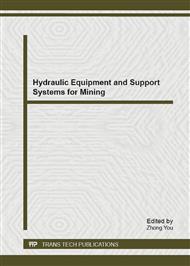p.503
p.508
p.512
p.518
p.522
p.531
p.536
p.541
p.545
The Simulation Research on Travel-Driven System of Powered Platform Lorry
Abstract:
In order to improve the power performance and fuel economy performance of powered platform lorry, this paper analyses the characteristics of hydraulic system and engine to make three-close-loop control strategy. Its physical model is built with AMESim simulation software and the three-close-loop control strategy controller for the system is constructed in Matlab/Simulink environment. To evaluate the three close-loop control strategy, a co-simulation method with AMESim/Simulink is used. The simulation results show the control strategy is effective to improve the efficiency of the hydraulic drive system, the utilization of engine power, and the life of hydraulic components.
Info:
Periodical:
Pages:
522-527
Citation:
Online since:
December 2012
Authors:
Price:
Сopyright:
© 2013 Trans Tech Publications Ltd. All Rights Reserved
Share:
Citation:


